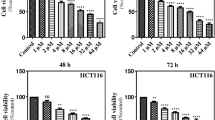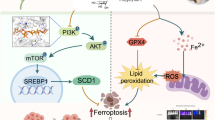Abstract
Cardenolides are cardiac glycosides, mostly obtained from natural sources. They are well known for their inhibitory action on the Na,K-ATPase, an effect that regulates cardiovascular alterations such as congestive heart failure and atrial arrhythmias. In recent years, they have also sparked new interest in their anticancer potential. In the present study, the cytotoxic effects of the natural cardenolide convallatoxin (CON) were evaluated on non-small cell lung cancer (A549 cells). It was found that CON induced cytostatic and cytotoxic effects in A549 cells, showing essentially apoptotic cell death, as detected by annexin V-propidium iodide double-staining, as well as changes in cell form. In addition, it prompted cell cycle arrest in G2/M and reduced cyclin B1 expression. This compound also increased the number of cells in subG1 in a concentration- and time-dependent manner. At a long term, the reduction of cumulative population doubling was shown along with an increase of β-galactosidase positive cells and larger nucleus, indicative of senescence. Subsequently, CON inhibited the Na,K-ATPase in A549 cells at nM concentrations. Interestingly, at the same concentrations, CON was unable to directly inhibit the Na,K-ATPase, either in pig kidney or in red blood cells. Additionally, results of docking calculations showed that CON binds with high efficiency to the Na,K-ATPase. Taken together, our data highlight the potent anticancer effects of CON in A549 cells, and their possible link with non-classical inhibition of Na,K-ATPase.








Similar content being viewed by others
Abbreviations
- CON:
-
Convallatoxin
- NSCLC:
-
Non-small cell lung cancer
- PAC:
-
Paclitaxel
- FBS:
-
Fetal bovine serum
- TB:
-
Trypan blue
- NII:
-
Nuclear irregularity index
- SDS:
-
Sodium dodecyl sulfate
- DOC:
-
Deoxycholate
- EDTA:
-
Ethylenediaminetetraacetic acid
- RIPA:
-
Radioimmunoprecipitation assay buffer
- PVDF:
-
Polyvinylidene fluoride
- DAPI:
-
4′,6-Diamidino-2-phenylindole
- EGTA:
-
Ethylene glycol tetraacetic acid
- FACS:
-
Fluorescence-activated cell sorting.
References
Siegel RL, Miller KD, Jemal A (2015) Cancer statistics, 2015. CA Cancer J Clin 65:5–29. doi:10.3322/caac.21254
Koh PK, Faivre-Finn C, Blackhall FH, De Ruysscher D (2012) Targeted agents in non-small cell lung cancer (NSCLC): clinical developments and rationale for the combination with thoracic radiotherapy. Cancer Treat Rev 38:626–640. doi:10.1016/j.ctrv.2011.11.003
Holohan C, Van Schaeybroeck S, Longley DB, Johnston PG (2013) Cancer drug resistance: an evolving paradigm. Nat Rev Cancer 13:714–726. doi:10.1038/nrc3599
Cragg GM, Newman DJ (2013) Natural products: a continuing source of novel drug leads. Biochim Biophys Acta 1830:3670–3695. doi:10.1016/j.bbagen.2013.02.008
Newman DJ, Cragg GM (2016) Natural products as sources of new drugs from 1981 to 2014. J Nat Prod 75:311–335. doi:10.1021/np200906s
Winnicka K, Bielawski K, Bielawska A (2006) Cardiac glycosides in cancer research. Acta Pol Pharm 63:109–115
Newman RA, Yang P, Pawlus AD, Block KI (2008) Cardiac glycosides as novel cancer therapeutic agents. Mol Interv 8:36–49. doi:10.1124/mi.8.1.8
Cerella C, Dicato M, Diederich M (2013) Assembling the puzzle of anti-cancer mechanisms triggered by cardiac glycosides. Mitochondrion 13:225–234. doi:10.1016/j.mito.2012.06.003
Mijatovic T, Van Quaquebeke E, Delest B et al (2007) Cardiotonic steroids on the road to anti-cancer therapy. Biochim Biophys Acta 1776:32–57. doi:10.1016/j.bbcan.2007.06.002
Wang Y, Qiu Q, Shen J-J et al (2012) Cardiac glycosides induce autophagy in human non-small cell lung cancer cells through regulation of dual signaling pathways. Int J Dev Biol 44:1813–1824. doi:10.1016/j.biocel.2012.06.028
Felth J, Rickardson L, Rosén J et al (2009) Cytotoxic effects of cardiac glycosides in colon cancer cells, alone and in combination with standard chemotherapeutic drugs. J Nat Prod 72:1969–1974. doi:10.1021/np900210m
Cerella C, Muller F, Gaigneaux A et al (2015) Early downregulation of Mcl-1 regulates apoptosis triggered by cardiac glycoside UNBS1450. Cell Death Dis 6:e1782. doi:10.1038/cddis.2015.134
Chanvorachote P, Pongrakhananon V (2013) Ouabain downregulates Mcl-1 and sensitizes lung cancer cells to TRAIL-induced apoptosis. Am J Physiol Cell Physiol 304:263–272. doi:10.1152/ajpcell.00225.2012
Elbaz HA., Stueckle TA., Wang HYL et al (2012) Digitoxin and a synthetic monosaccharide analog inhibit cell viability in lung cancer cells. Toxicol Appl Pharmacol 258:51–60. doi:10.1016/j.taap.2011.10.007
Pongrakhananon V, Stueckle TA, Wang HL et al (2014) Monosaccharide digitoxin derivative sensitize human non-small cell lung cancer cells to anoikis through Mcl-1 proteasomal degradation. Biochem Pharmacol 88:23–35. doi:10.1016/j.bcp.2013.10.027
Hong DS, Henary H, Falchook GS et al (2014) First-in-human study of pbi-05204, an oleander-derived inhibitor of akt, fgf-2, nf-κΒ and p70s6k, in patients with advanced solid tumors. Invest New Drugs 32:1204–1212. doi:10.1007/s10637-014-0127-0
Schneider NFZ, Geller FC, Persich L et al (2016) Inhibition of cell proliferation, invasion and migration by the cardenolides digitoxigenin monodigitoxoside and convallatoxin in human lung cancer cell line. Nat Prod Res 30:1327–1331. doi:10.1080/14786419.2015.1055265
Yang SY, Kim NH, Cho YS et al (2014) Convallatoxin, a dual inducer of autophagy and apoptosis, inhibits angiogenesis in vitro and in vivo. PloS ONE 9:e91094. doi:10.1371/journal.pone.0091094
Levrier C, Kiremire B, Guéritte F, Litaudon M (2012) Toxicarioside M, a new cytotoxic 10β-hydroxy-19-nor-cardenolide from Antiaris toxicaria. Fitoterapia 83:660–664. doi:10.1016/j.fitote.2012.02.001
Prassas I, Karagiannis GS, Batruch I et al (2011) Digitoxin-induced cytotoxicity in cancer cells is mediated through distinct kinase and interferon signaling networks. Mol Cancer Ther 10:2083–2093. doi:10.1158/1535-7163.MCT-11-0421
Babula P, Masarik M, Adam V et al (2013) From Na+/K+-ATPase and cardiac glycosides to cytotoxicity and cancer treatment. Anticancer Agents Med Chem 13:1069–1087. doi:10.2174/18715206113139990304
Jorgensen PL, Håkansson KO, Karlish SJD (2003) Structure and Mechanism of Na, K-ATPase: functional sites and their interactions. Annu Rev Physiol 65:817–849. doi:10.1146/annurev.physiol.65.092101.142558
Blanco G, Mercer RW (1998) Isozymes of the Na-K-ATPase: heterogeneity in structure, diversity in function. Am J Physiol 275:F633–F650. doi:10.1152/ajprenal.00721.2010
Khan MI, Chesney JA, Laber DA, Miller DM (2009) Digitalis, a targeted therapy for cancer? Am J Med Sci 337:355–359. doi:10.1097/MAJ.0b013e3181942f57
Mijatovic T, Kiss R (2013) Cardiotonic steroids-mediated Na+/K+-ATPase targeting could circumvent various chemoresistance pathways. Planta Med 79:189–198. doi:10.1055/s-0032-1328243
Cereijido M, Contreras RG, Shoshani L, Larre I (2012) The Na, K-ATPase as self-adhesion molecule and hormone receptor. Am J Physiol Cell Physiol 302:C473–C481. doi:10.1152/ajpcell.00083.2011
Strober W (2001) Trypan blue exclusion test of cell viability. Curr Protoc Immunol. doi:10.1002/0471142735.ima03bs21.
Franken NAP, Rodermond HM, Stap J et al (2006) Clonogenic assay of cells in vitro. Nat Protoc 1:2315–2319. doi:10.1038/nprot.2006.339
Filippi-Chiela EC, Oliveira MM, Jurkovski B et al (2012) Nuclear morphometric analysis (NMA): screening of senescence, apoptosis and nuclear irregularities. PLoS ONE. doi:10.1371/journal.pone.0042522
Riccardi C, Nicoletti I (2006) Analysis of apoptosis by propidium iodide staining and flow cytometry. Nat Protoc 1:1458–1461. doi:10.1038/nprot.2006.238
Henry CM, Hollville E, Martin SJ (2013) Measuring apoptosis by microscopy and flow cytometry. Methods 61:90–97. doi:10.1016/j.ymeth.2013.01.008
Silva AO, Felipe KB, Villodre ES et al (2016) A guide for the analysis of long-term population growth in cancer. Tumor Biol 37:13743–13749. doi:10.1007/s13277-016-5255-z
Stewart JJP (2013) Optimization of parameters for semiempirical methods VI: more modifications to the NDDO approximations and re-optimization of parameters. J Mol Model 19:1–32. doi:10.1007/s00894-012-1667-x
Stweart JJP (2012) Stewart computational chemistry. MOPAC2012. http://OpenMOPAC.net
Laursen M, Yatime L, Nissen P, Fedosova NU (2013) Crystal structure of the high-affinity Na + K+-ATPase-ouabain complex with Mg2+ bound in the cation binding site. Proc Natl Acad Sci USA 110:10958–10963. doi:10.1073/pnas.1222308110
Jaghoori MM, Bleijlevens B, Olabarriaga SD (2016) 1001 ways to run AutoDock Vina for virtual screening. J Comput Aided Mol Des 30:237–249. doi:10.1007/s10822-016-9900-9
Rocha SC, Pessoa MTC, Neves LDR et al (2014) 21-benzylidene digoxin: a proapoptotic cardenolide of cancer cells that up-regulates Na, K-ATPase and epithelial tight junctions. PLoS ONE 9:e108776. doi:10.1371/journal.pone.0108776
Trott O, Olson A (2010) NIH public access. J Comput Chem 31:455–461. doi:10.1002/jcc.21334.AutoDock
Accelrys Software Inc (2013) Discovery studio modeling environment, release 4.5.
Jorgensen P (1974) Purification and characterization of (Na + plus K+)-ATPase. 3. Purification from the outer medulla of mammalian kidney after selective removal of membrane components by sodium dodecylsulphate. Biochim Biophys Acta 12:36–52
Jensen BYJ, Nrby JG, Ottolenghi P (1984) Binding of sodium and potassium to the sodium pump of pig kidney evaluated from nucleotide-binding behaviour. J Physiol 346:219–241
Sousa L, Garcia IJP, Costa TGF et al (2015) Effects of iron overload on the activity of Na, K-ATPase and lipid profile of the human erythrocyte membrane. Plos ONE 10:e0132852. doi:10.1371/journal.pone.0132852
Fiske C, Subbarow Y (1825) The colorimetric determination of phosphorus. J Biol Chem 66:375–400
Noël F, Pimenta PHC, Dos Santos AR et al (2011) ∆2,3-ivermectin ethyl secoester, a conjugated ivermectin derivative with leishmanicidal activity but without inhibitory effect on mammalian P-type ATPases. Naunyn–Schmiedeberg’s Arch Pharm 383:101–107. doi:10.1007/s00210-010-0578-6
Klaus B (2016) Statistical relevance—relevant statistics, part II†¯: presenting experimental data. EMBO J 35:1–4. doi:10.15252/embj.201694659
Liu Q, Tang J-S, Hu M-J et al (2013) Antiproliferative cardiac glycosides from the latex of Antiaris toxicaria. J Nat Prod 76:1771–1780. doi:10.1021/np4005147
Shi LS, Kuo SC, Sun HD et al (2014) Cytotoxic cardiac glycosides and coumarins from Antiaris toxicaria. Bioorg Med Chem 22:1889–1898. doi:10.1016/j.bmc.2014.01.052
Kuete V, Vouffo B, Mbaveng AT et al (2009) Evaluation of Antiaris africana methanol extract and compounds for antioxidant and antitumor activities. Pharm Biol 47:1042–1049. doi:10.3109/13880200902988595
Kaushik V, Yakisich J, Azad N et al (2016) Anti-tumor effects of cardiac glycosides on human lung cancer cells and lung tumorspheres. J Cell Physiol. doi:10.1002/jcp.25611
Zhou S, Zhao L, Kuang M et al (2012) Autophagy in tumorigenesis and cancer therapy: Dr. Jekyll or Mr. Hyde? Cancer Lett 323:115–127. doi:10.1016/j.canlet.2012.02.017
Leu WJ, Chang HS, Chan SH et al (2014) Reevesioside A, a cardenolide glycoside, induces anticancer activity against human hormone-refractory prostate cancers through suppression of c-myc expression and induction of G1 arrest of the cell cycle. PLoS ONE 9:1–13. doi:10.1371/journal.pone.0087323
Lapenna S, Giordano A (2009) Cell cycle kinases as therapeutic targets for cancer. Nat Rev Drug Disc 8:547–566. doi:10.1038/nrd2907
Van Quaquebeke E, Simon G, RE A et al (2005) Identification of a novel cardenolide (2′’-oxovoruscharin) from Calotropis procera and the hemisynthesis of novel derivatives displaying potent in vitro antitumor activities and high in vivo tolerance: structure–activity relationship analyses. J Med Chem 48:849–856. doi:10.1021/jm049405a
Juncker T, Cerella C, Teiten M et al (2011) UNBS1450, a steroid cardiac glycoside inducing apoptotic cell death in human leukemia cells. Biochem Pharmacol 81:13–23. doi:10.1016/j.bcp.2010.08.025
Feng B, Guo Y-W, Huang C-G et al (2010) 2′-epi-2′-O-acetylthevetin B extracted from seeds of Cerbera manghas L. induces cell cycle arrest and apoptosis in human hepatocellular carcinoma HepG2 cells. Chem Biol Interact 183:142–153. doi:10.1016/j.cbi.2009.10.012
Kulikov A, Eva A, Kirch U et al (2007) Ouabain activates signaling pathways associated with cell death in human neuroblastoma. Biochim Biophys Acta 1768:1691–1702. doi:10.1016/j.bbamem.2007.04.012
Bielawski K, Winnicka K, Bielawska A (2006) Inhibition of DNA topoisomerases I and II, and growth inhibition of breast cancer MCF-7 cells by ouabain, digoxin and proscillaridin A. Biol Pharm Bull 29:1493–1497
Weigand KM, Laursen M, Swarts HGP et al (2014) Na+,K+-ATPase isoform selectivity for digitalis-like compounds is determined by two amino acids in the first extracellular loop. Chem Res Toxicol 27:2082–2092. doi:10.1021/tx500290k
Alves SLG, Paixão N, Ferreira LGR et al (2015) c-Benzylidene digoxin derivatives synthesis and molecular modeling†¯: evaluation of anticancer and the Na, K-ATPase activity effect. Bioorg Med Chem 23:4397–4404. doi:10.1016/j.bmc.2015.06.028
Trenti A (2012) Analysis of the molecular mechanisms of the antineoplastic effect of ouabain. Università degli Studi di Padova
Pierre SV, Sottejeau Y, Gourbeau J et al (2008) Isoform specificity of Na-K-ATPase-mediated ouabain signaling. Am J Physiol Renal Physiol 1:859–866. doi:10.1152/ajprenal.00089.2007.
Xie J, Ye Q, Cui X et al (2015) Expression of rat Na-K-ATPase alpha 2 enables ion pumping but not ouabain-induced signaling in alpha1-deficient porcine renal epithelial cells. Am J Physiol Cell Physiol 309:C373–C382. doi:10.1152/ajpcell.00103.2015
Slingerland M, Cerella C, Guchelaar HJ et al (2013) Cardiac glycosides in cancer therapy: from preclinical investigations towards clinical trials. Invest New Drugs 31:1087–1094. doi:10.1007/s10637-013-9984-1
Acknowledgements
The Brazilian authors would like to thank the funding agencies CAPES /MEC (Ministry of Education) and CNPq/MCTI (Ministry of Science, Technology and Innovation) for their research scholarships. This work was also supported by the CNPq [Grants 472544/2013-6 and 490057/2011-0], the Marie Curie Foundation—IRSES/European Community [Grant 295251], and CAPES [Grant PNPD 2257/2011].
Author information
Authors and Affiliations
Corresponding author
Electronic supplementary material
Below is the link to the electronic supplementary material.
Rights and permissions
About this article
Cite this article
Schneider, N.F.Z., Silva, I.T., Persich, L. et al. Cytotoxic effects of the cardenolide convallatoxin and its Na,K-ATPase regulation. Mol Cell Biochem 428, 23–39 (2017). https://doi.org/10.1007/s11010-016-2914-8
Received:
Accepted:
Published:
Issue Date:
DOI: https://doi.org/10.1007/s11010-016-2914-8




